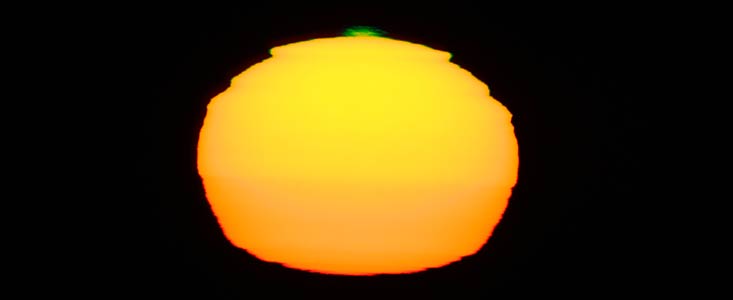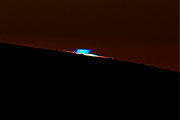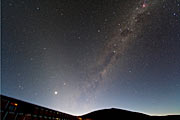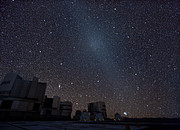Nota de prensa
JUEGOS SOLARES EN PARANAL
2 de Mayo de 2008
Cerro Paranal, el hogar del Very Large Telescope de ESO, es sin duda uno de los mejores sitios astronómicos del planeta. Desde este sitio privilegiado, funcionarios de Paranal lograron captar imágenes impresionantes de los famosos destellos verde y azul, así como el “Gegenschein”, un fenómeno muy difícil de observar.
La atmósfera terrestre es un prisma gigante que dispersa la luz del Sol. Ante condiciones atmosféricas ideales, como las que ofrece regularmente Cerro Paranal, es posible que aparezca el famoso destello verde o azul en la puesta de Sol. Este fenómeno es tan popular en el observatorio, que ya es tradición para quieres trabajan en Paranal reunirse a diario en la plataforma del telescopio para disfrutar la puesta de Sol, y ojalá ver el destello verde, antes de comenzar una larga noche de observaciones.
El destello verde, así como el azul, son eventos fugaces que requieren una atmósfera muy estable y una visión de la puesta de Sol sin obstrucciones. Estas condiciones se dan frecuentemente en el Observatorio Paranal, ubicado a 2.635 metros de altura en el Desierto de Atacama en Chile, donde el cielo está libre de nubes más de 300 días al año. Paranal es el hogar del Very Large Telescope de ESO, un conjunto de cuatro telescopios de 8,2 metros de diámetro y cuatro Telescopios Auxiliares de 1,8 metros, que combinados conforman el telescopio óptico más avanzado del mundo.
El ingeniero de ESO Stéphane Guisard ha perseguido los destellos verdes durante años y ha sido capaz de fotografiar este fenómeno en varias ocasiones. La foto publicada en esta página es una de las numerosas que posee en su colección personal. “Los más difícil es captar el destello verde cuando todavía se aprecia el resto del Sol con todo su colorido”, dice Guisard.
Su colega Guillaume Blanchard fue todavía más afortunado. En la víspera de Navidad, cuando había muy pocos siguiendo la tradición de ver la puestas de Sol, pudo inmortalizar un destello azul con su telescopio amateur.
El astrónomo de ESO Yuri Beletsky también es aficionado a tomar fotografías desde Paranal, pero prefiere las vistas nocturnas. Esto le permitió aprovechar las condiciones únicas sobre Paranal para obtener imágenes impresionantes del cielo nocturno. En una de ellas logró inmortalizar otro fenómeno interesante relacionado con el Sol: la llamada “luz Zodiacal” y el “Gegenschein”.
Tanto la luz Zodiacal como el Gegenschein (del alemán “contra brillo”) son producto de la luz solar reflejada por el polvo interplanetario. Estos fenómenos son tan tenues que sólo se pueden ver en lugares libres de contaminación lumínica.
La mayor parte del polvo interplanetario en nuestro Sistema Solar se encuentra en la elíptica, el plano por el cual se mueven los planetas alrededor del Sol, por lo tanto la luz Zodiacal y el Gegenschein se pueden observar en la región central de la elíptica. Mientras la luz Zodiacal se ve cerca del Sol, el Gegenschein se ve en la dirección opuesta.
Las pequeñas partícula de polvo, restos de cometas y asteroides, actúan como pequeñas lunas que reflejan la luz proveniente de nuestra estrella. “Si pudiéramos observar las partículas individuales de polvo, entonces veríamos que las ubicadas al centro del Gegenschein parecen pequeñas lunas llenas, mientras que las ocultas en la parte más tenue de la franja de polvo parecen pequeñas lunas crecientes”, explica el astrónomo de ESO Colin Snodgrass. “Pero incluso el VLT es incapaz de ver partículas de polvo tan pequeñas en el espacio. En cambio vemos el efecto combinado, en fotos como esta, de millones de pequeñas partículas de polvo reflejando luz del Sol hacia nosotros”.
Contactos
Stéphane Guisard
ESO
Chile, Chile
Correo electrónico: sguisard@eso.org
Guillaume Blanchard
ESO
Chile, Chile
Correo electrónico: gblancha@eso.org
Yuri Beletsky
ESO
Chile, Chile
Correo electrónico: ybialets@eso.org
José Miguel Mas Hesse (Contacto para medios de comunicación en España)
Red de Difusión Científica de ESO
y Centro de Astrobiología (CSIC-INTA)
Madrid, Spain
Teléfono: +34 918131196
Correo electrónico: eson-spain@eso.org
Acerca de la nota de prensa
| Nota de prensa No.: | eso0812-es |
| Legacy ID: | PR 12/08 |
| Nombre: | Sun |
| Tipo: | Milky Way : Sky Phenomenon : Night Sky : Zodiacal Light Milky Way : Sky Phenomenon : Night Sky : Zodiacal Light : Gegenschein Milky Way : Sky Phenomenon : Light Phenomenon : Sunrise-Sunset : Green flash |
| Facility: | Very Large Telescope |
Our use of Cookies
We use cookies that are essential for accessing our websites and using our services. We also use cookies to analyse, measure and improve our websites’ performance, to enable content sharing via social media and to display media content hosted on third-party platforms.
ESO Cookies Policy
The European Organisation for Astronomical Research in the Southern Hemisphere (ESO) is the pre-eminent intergovernmental science and technology organisation in astronomy. It carries out an ambitious programme focused on the design, construction and operation of powerful ground-based observing facilities for astronomy.
This Cookies Policy is intended to provide clarity by outlining the cookies used on the ESO public websites, their functions, the options you have for controlling them, and the ways you can contact us for additional details.
What are cookies?
Cookies are small pieces of data stored on your device by websites you visit. They serve various purposes, such as remembering login credentials and preferences and enhance your browsing experience.
Categories of cookies we use
Essential cookies (always active): These cookies are strictly necessary for the proper functioning of our website. Without these cookies, the website cannot operate correctly, and certain services, such as logging in or accessing secure areas, may not be available; because they are essential for the website’s operation, they cannot be disabled.
Functional Cookies: These cookies enhance your browsing experience by enabling additional features and personalization, such as remembering your preferences and settings. While not strictly necessary for the website to function, they improve usability and convenience; these cookies are only placed if you provide your consent.
Analytics cookies: These cookies collect information about how visitors interact with our website, such as which pages are visited most often and how users navigate the site. This data helps us improve website performance, optimize content, and enhance the user experience; these cookies are only placed if you provide your consent. We use the following analytics cookies.
Matomo Cookies:
This website uses Matomo (formerly Piwik), an open source software which enables the statistical analysis of website visits. Matomo uses cookies (text files) which are saved on your computer and which allow us to analyze how you use our website. The website user information generated by the cookies will only be saved on the servers of our IT Department. We use this information to analyze www.eso.org visits and to prepare reports on website activities. These data will not be disclosed to third parties.
On behalf of ESO, Matomo will use this information for the purpose of evaluating your use of the website, compiling reports on website activity and providing other services relating to website activity and internet usage.
Matomo cookies settings:
Additional Third-party cookies on ESO websites: some of our pages display content from external providers, e.g. YouTube.
Such third-party services are outside of ESO control and may, at any time, change their terms of service, use of cookies, etc.
YouTube: Some videos on the ESO website are embedded from ESO’s official YouTube channel. We have enabled YouTube’s privacy-enhanced mode, meaning that no cookies are set unless the user actively clicks on the video to play it. Additionally, in this mode, YouTube does not store any personally identifiable cookie data for embedded video playbacks. For more details, please refer to YouTube’s embedding videos information page.
Cookies can also be classified based on the following elements.
Regarding the domain, there are:
- First-party cookies, set by the website you are currently visiting. They are stored by the same domain that you are browsing and are used to enhance your experience on that site;
- Third-party cookies, set by a domain other than the one you are currently visiting.
As for their duration, cookies can be:
- Browser-session cookies, which are deleted when the user closes the browser;
- Stored cookies, which stay on the user's device for a predetermined period of time.
How to manage cookies
Cookie settings: You can modify your cookie choices for the ESO webpages at any time by clicking on the link Cookie settings at the bottom of any page.
In your browser: If you wish to delete cookies or instruct your browser to delete or block cookies by default, please visit the help pages of your browser:
Please be aware that if you delete or decline cookies, certain functionalities of our website may be not be available and your browsing experience may be affected.
You can set most browsers to prevent any cookies being placed on your device, but you may then have to manually adjust some preferences every time you visit a site/page. And some services and functionalities may not work properly at all (e.g. profile logging-in, shop check out).
Updates to the ESO Cookies Policy
The ESO Cookies Policy may be subject to future updates, which will be made available on this page.
Additional information
For any queries related to cookies, please contact: pdprATesoDOTorg.
As ESO public webpages are managed by our Department of Communication, your questions will be dealt with the support of the said Department.




